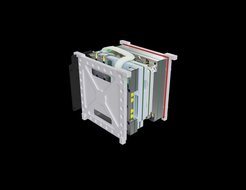Receivers in space
Small satellites are the future of space travel. They weigh less than 500 kilograms and can also be carried into space by small launch vehicles. Since they can be produced in larger quantities, they are cheaper than conventional satellites, they open up completely new possibilities for science and commercial services. Icarus is also betting on the new technology: in October 2024, an Icarus receiver will fly into space on board a small satellite.

Until spring 2022, the International Space Station ISS acted as a receiving station for the signals from the Icarus transmitters. The ISS orbits the Earth at an altitude of around 400 kilometres and thus flies comparatively low. It was therefore well suited for the low transmission power of the Icarus transmitters. This enabled the researchers to keep the energy consumption of the transmitters low. From autumn 2024, Icarus will use modern, commercially operated small satellites from the Munich-based start-up OroraTech, so-called "CubeSats", instead of the ISS. The modern satellites have the advantage that they are cheap, have been tested many times, can be launched into space quickly and are easy to use. Unlike the ISS, they also cover every point on Earth, the technology used requires less space and is open to other partners and satellites. The CubeSats are small satellites that combine between one and 16 cubes ("U") with an edge length of ten centimetres. They can be used to easily operate technical equipment in space. The Icarus cube on the CubeSat is built by Talos, a Munich-based company that develops satellite-based positioning technology for research, agriculture and logistics.
A new Icarus receiver also brings significant improvements for research: it requires less energy than the old system while offering higher performance, it transmits data faster and covers the entire surface of the earth. This means that animals anywhere on Earth can transmit valuable information about their own health and the health of their surroundings. The receiver is housed in a cube with an edge length of ten centimetres and weighs about two kilograms. While the old Icarus antenna was three metres long and the computer on the ISS was the size of a PC, the new foldable antenna is only twenty centimetres long and the computer the size of a thumb. Compared to its predecessor, the Icarus receiver consumes only a tenth of the energy, but can read four times more transmitters on the animals at the same time. Researchers can thus download data faster, reprogram transmitters and collect data more efficiently.
Low orbit

Like the ISS and many other satellites, the Icarus-CubeSat will be in a low-Earth orbit. At the comparatively short distance of 500 kilometres, the CubeSat can orbit the Earth several times a day and thus fly over every point on the Earth's surface. In contrast, the ISS does not cover the Arctic and polar regions beyond southern Sweden in the north and the southern tip of Chile in the south. With its orbit, the Icarus-CubeSat and its receiver system can collect data from animals wherever they are - be it in deserts, on polar ice fields, over oceans or in the air. The Icarus receiver system in space reads out the data once a day. In this way, scientists regularly receive information about the behaviour of animals on Earth. In the future, the Icarus-CubeSat system will be expanded by a network of satellites. This will again significantly increase the number of daily readouts.
Currently, planning is underway for a second Icarus CubeSat payload in 2025 and a third for 2026. The goal is to have enough satellites to be able to transmit data in near real time.

